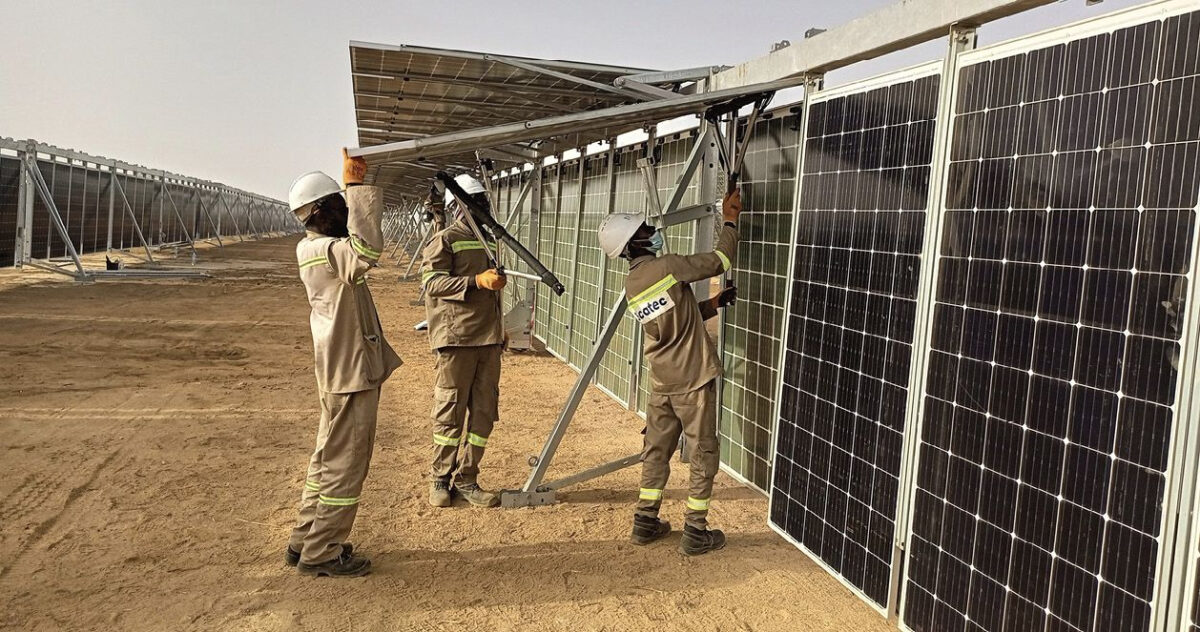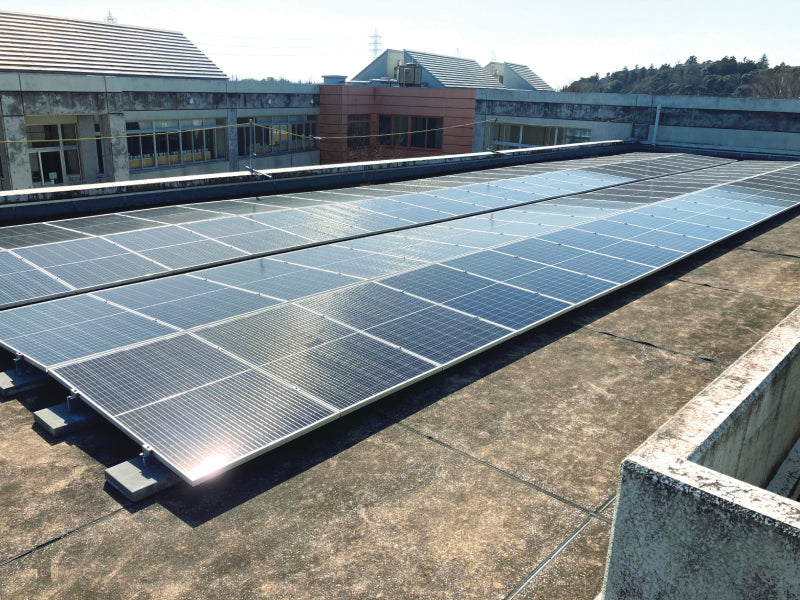https://www.pv-magazine.com/2023/11/04/weekend-read-install-grid-connected-solar-rinse-repeat/
Install grid-connected solar, rinse, repeat

Release by Scatec says its redeployable solar and energy storage systems will enable African grid operators to shore up aging electricity networks.
Photo: Scatec
Clean energy company Scatec is pitching “Release by Scatec” – its redeployable solar generation and energy storage system – as a key tool for African utilities struggling with aging grids.
The Norwegian business has secured $102 million from Netherlands-based blended finance specialist Climate Fund Managers (CFM). Scatec told pv magazine that the “pre-assembled, modular, scalable, and redeployable” systems – popular with off-grid mining operations – were envisioned with patchy grids and struggling utilities in mind.
Hans Olav Kvalvaag, CEO of Release by Scatec, said the product was mainly started to solve problems of utilities and offtakers that require flexibility. “The conventional [solar] IPP [independent power provider] model takes forever: agreeing plans with parliament, funders, getting a generation license, and so many other licenses. We thought ‘how can we possibly solve this?’”
Kvalvaag pointed to 36 MW of Release generation capacity and 20 MWh of battery storage for a local utility in Cameroon as an example of the system’s grid application.
That project is plugged into a wider regional grid in the north of the country. The modular, quick-to-install nature of a system that can provide off-grid power and storage, however, has reopened the debate into how much of Africa’s future grids should be based on traditional, centralized-generation, as well as the sort of role that off-grid installations will play.
Grid or off-grid?
“This distinction between off-grid and on-grid [is that] there will be so many solutions, from home solar panels, to an EV [electric vehicle] battery and inverter, to villages with 10 households, to microgrids, minigrids, regional grids,” said Kvalvaag. “It’s all about building solutions that fit. Norway likes to think it has the most advanced power system in the world but we have the same problems here, if not on the same scale as in Africa: Generation and demand never fit perfectly. If we built the grid from scratch today, in Norway, it would look very, very different and that is the opportunity for Africa now that technology has moved on. We can plan, starting with off-grid and minigrid solutions, and build it up further.”
That view was echoed by Darron Johnson, Africa regional head of investments at CFM – a joint venture owned by Dutch state development lender Nederlandse Financierings-Maatschappij voor Ontwikkelingslanden and South African insurance and financial services entity Sanlam Group.
“At no point have Hans-Olav or I talked about on-grid or off-grid as a distinction,” said Johnson. “I think the point Hans-Olav is making about a range of solutions harks back to when electricity provision was first provided by individual city blocks in New York. Then the engineers said, if they connected all the blocks they’d have a much more efficient system.”
Johnson added that, in Africa, there is “so much need for power” that one can simply “follow the demand … I think that’s best done on a similar basis, with minigrids, and then you start connecting them where the connections are obvious.”
Future networks
“That’s the beauty of solar, right?” said Kvalvaag. “You can include solar – everything from a 500 W panel to a 500 MW plant – when you actually need it. Batteries can then, to some extent, balance power when it is needed. I think this is how utilities in Africa should think about constructing their grids. It’s a bit like jumping over fixed telephone lines to go straight to mobile phones.”
The concept of electricity provision in Africa being able to “leapfrog” the traditional model to one that is decentralized has been espoused by renewable energy advocates for some time. However, some off-grid, pay-as-you-go solar system providers have encountered difficulties and come in for criticism – in the worst cases, they have been accused of signing up African households to unaffordable long-term contracts.
Many African centralized utilities have also failed to plug the electrification gap. Some are saddled with debt and speculation continues about the potentially dominant role off-grid solar and private companies can play in the continent’s energy future.
Consultant Chigozie Nweke-Eze, founder and CEO of Integrated Africa Power, talked numbers when asked what sort of off-grid, on-grid split might be anticipated in his home country of Nigeria this decade.
“I think it may end up being 50/50, simply because of the geographical context,” he offered, referring to similarly sized urban and rural populations. “The urban areas will continue to depend on grid systems. Communities that are off-grid will use decentralized systems. That way, there’s a market for people like Scatec to come in and explore how they can do things.”
A 50/50 split would be quite the leap with the Statista website estimating 70.5% of Nigeria’s electricity came from gas last year, plus 27.3% from hydro.
New idea
Nweke-Eze noted the appeal of redeployable systems, such as Release, for utilities.
“Products like this will attract competition so everyone will try their best to have the lowest-cost option,” he said. “I still see room for all of them to be players. I see some utilities that are very traditional and will continue to depend on grid infrastructure and others that will try new solutions, like redeployable equipment, perhaps while they wait for grid infrastructure itself.
“Oftentimes it’s quite slow for infrastructure to come out where it needs to be. The question is, do you want to wait or do you want to start using electricity before the infrastructure comes?”
Stopgap, easily deployed modular systems for utilities appears to be what Release is hoping for. “I think these solutions will remain and you’ll just build around them with infrastructure,” Kvalvaag said.
Popular content
He told pv magazine that the idea behind the company's product in Liberia, Cameroon, and Ukraine was to start to build capacity where the energy bottlenecks are.
“It’s tremendously helpful to the grid not to oversize transmission lines,” he added. “If you only work with off-grid solutions, you will have to oversize your generation capacity. If you only work with grids, you will have to oversize your transmission capacity.”
What the press release issued to announce CFM’s backing for Release did not spell out was one of the most salient features, for investors, of having redeployable equipment.
Redeployable assets
“The reason we wanted a mobile, redeployable solution,” said Kvalvaag, “is to be able to react to complicated utilities and offtakers. If people don’t pay for the power, we can actually take the equipment back.”
That means investors wary of backing costly equipment for cash-strapped utilities – particularly in unstable political climates – might be more prepared to take the plunge.
On the flip side, as Nweke-Eze pointed out, “everyone needs electricity and no-one will be happy to see it moved away because a utility couldn’t afford it. But that is the private sector for you; it’s profit driven.
“Of course we hope that will not be the case [equipment removal] but there’s also room for private-sector co-operation in this context. Maybe MoUs [memoranda of understanding] could be signed that, in the event of a delay collecting fees, they should have to wait for a while before removing equipment, to provide a buffer period.”
CFM’s Johnson said the mobile nature of the product means it can be leased by utilities, for much less than purchasing equipment, and is much cheaper than funding grid infrastructure.
“The Release system offers a strategic advantage [to utilities] by tailoring the financing model to the offtakers’ requirements, rather than focusing on the asset lifespan,” said Johnson. “The leasing model provides flexibility in terms and purchase structure. By contrast, the traditional approach entails funding fixed infrastructure over its 20-year lifespan – a perspective that poses challenges for both utilities and financiers.”
Business model
Private finance can help back the wider infrastructure required to support grids.
“It’s really about how you price the service of a transmission line,” Johnson said. “There are lines that have a very low electron flow but which are critical to grid stability. A line like that is difficult to finance. If you think of it like a toll road, you’re not going to have many vehicles going along there but it will be full if the alternative road is congested.
“If you follow the basic PFI [private finance initiative] model in the UK, for example, a line would be financed by a service charge, a usage fee, or a mix of both. That works when a generator is connected to customers with a load similar to what a generator is generating but as soon as you start mixing in things like interconnectors it gets very complicated.”
The fact that Release can be removed at short notice means governments must play a role, said consultant Nweke-Eze.
“Do we want to leave it to the private sector, then?” he asked. “Without regulation? No, and that’s where government needs to come in and regulate and ensure customers are not being ripped off. They can also ensure private utilities are not oversizing profits.”
Temporary solution
Another concern is that if Release is as quick, cheap, and effective as its developers claim, there could be a risk utilities will rely on such temporary, leased systems rather than investing sufficiently in upgrading their grids, as a 50/50, on-grid, off-grid energy mix would require.
“The utilities that invest in large-scale connection will have smaller [electricity] unit prices,” said Nweke-Eze. “When this is the case, the market will speak for itself. Customers will always go for the cheapest option, the cheapest price, and that’s something we can leave the market to decide.”
Johnson is also doubtful that state utilities will abandon centralized generation.
“I don’t think governments and utilities would think like that,” he said. “We see the majority of the Release solutions being geared towards utilities, so they will be grid-connected. We’re not just chasing down corporate and industrial players, although we will equip them because it has environmental benefits. I don’t think utilities will want to throw their plans up and leave everything to the private sector. Actually, they tend to want to over-regulate.”
He added that the utilities are not looking to abdicate their responsibility. “It’s just a question of how they fulfill that role,” he explained. “If they try to do everything on their own, it’s just going to slow everything down.”
This content is protected by copyright and may not be reused. If you want to cooperate with us and would like to reuse some of our content, please contact: editors@pv-magazine.com.




